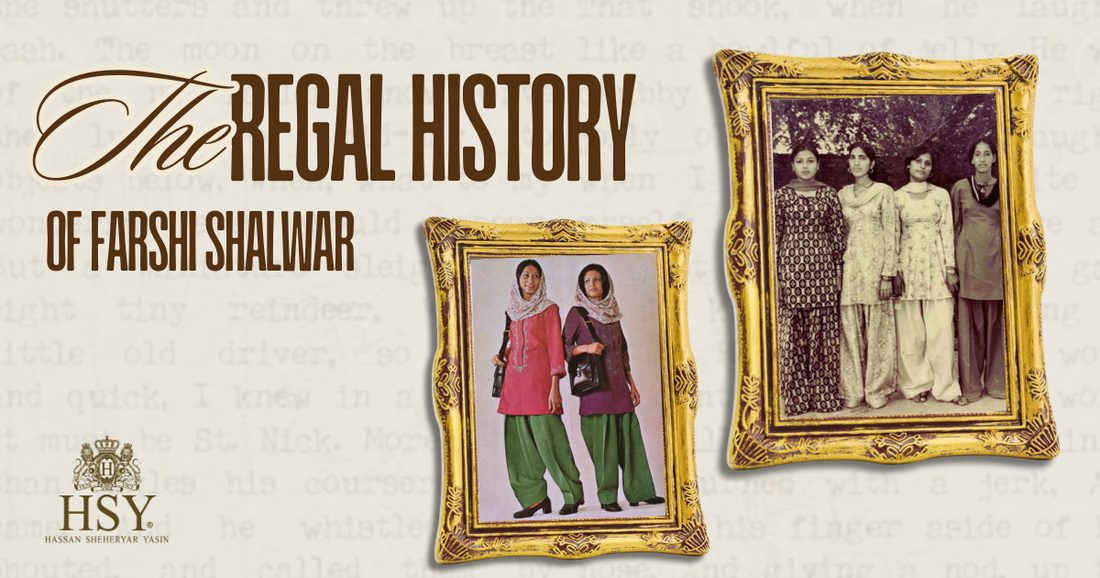
The regal history of farshi shalwar
Share
Imagine a silhouette that flows like poetry, trailing behind with an effortless grace—a vision of royalty, heritage, and timeless beauty. The farshi shalwar, a garment that once adorned the elegant women of Mughal courts, is a symbol of tradition woven with grandeur. This exquisite bottom-wear, known for its voluminous fabric and regal drape, is more than just clothing; it is an art form that speaks of history, craftsmanship, and culture.
Designers are blending aesthetics with this historic piece, incorporating lightweight fabrics like chiffon and organza for effortless draping. Embellishments are kept delicate yet striking, allowing women to embrace the grandeur without feeling overwhelmed. It is often styled with long, flowing kameezes, short frocks, or even peplum tops, depending on the event and personal preference.
• Jewelry Matters: Pair your outfit with jhumkas, chandbalis, or traditional polki jewelry to complete the regal aesthetic.
• Dupatta Draping: Opt for a flowing dupatta draped on one shoulder or carried gracefully over the arms for an elegant look.
• Footwear: Since the farshi shalwar pools around the feet, juttis or embroidered khussas are ideal footwear choices.
• Hair & Makeup: A sleek bun adorned with gajras (fresh flowers) or soft waves complement the traditional look beautifully.
Origin of farshi shalwar
The farshi shalwar finds its origins in the Mughal era, where queens and princesses embraced its charm in their royal ensembles. Unlike regular shalwars that taper at the ankles, the farshi shalwar flows into a wide flare, often extending to the floor and trailing like a gown. It was designed to be paired with long kameezes or intricately embroidered kurtas, enhancing the majestic appeal of the outfit.The craftsmanship behind farshi shalwar
A farshi shalwar is a masterpiece of tailoring. The lower half consists of multiple panels of fabric, cut meticulously to ensure the perfect fall. Traditionally, it was crafted from rich fabrics like silk, brocade, jamawar, and velvet, adding to its luxurious appeal. The hem is often adorned with zari work, gota, dabka, or intricate embroidery, making it a statement piece for special occasions. The construction of this shalwar requires a skilled artisan who understands the art of pleating and layering fabric to create an elegant yet structured look.How farshi shalwar is worn today
Fashion is a beautiful cycle where traditions are reimagined for contemporary wardrobes. Today, the farshi shalwar is experiencing a renaissance in South Asian fashion, becoming a beloved choice for brides, wedding guests, and cultural celebrations.Designers are blending aesthetics with this historic piece, incorporating lightweight fabrics like chiffon and organza for effortless draping. Embellishments are kept delicate yet striking, allowing women to embrace the grandeur without feeling overwhelmed. It is often styled with long, flowing kameezes, short frocks, or even peplum tops, depending on the event and personal preference.
Where to wear a farshi shalwar?
The grandeur of the farshi shalwar makes it perfect for wedding events, festive gatherings, and cultural celebrations. Here’s how it fits into different occasions:Mehndi (Pre-wedding celebration)
A vibrant farshi shalwar in hues of yellow, green, or orange, paired with a heavily embroidered short kameez or a peplum top, creates a stunning mehndi look. This is often complemented by fresh floral jewelry and traditional paranda-adorned braids.Nikkah (Wedding ceremony)
For this elegant affair, brides opt for pastel-toned farshi shalwars, often adorned with delicate embellishments. Paired with a long kurta and a dupatta draped like a veil, it creates a regal and sophisticated look.Baraat (Grand wedding reception)
A red or gold farshi shalwar ensemble with rich hand-embroidered motifs is a breathtaking choice for brides or close family members. Styled with a heavily embellished dupatta, this look embodies grandeur and heritage.Walima (Wedding banquet)
Soft, ethereal colors like powder blue, mint green, or champagne gold in flowing farshi shalwar designs exude effortless grace. Paired with a long organza or silk kurta, it is a refined choice for the occasion.Eid and festive gatherings
Women who love to embrace traditional wear on festive occasions opt for lightweight farshi shalwar suits adorned with subtle embroidery or block prints. These are comfortable yet exude the perfect festive charm.Styling tips for farshi shalwar
To truly embrace the charm of a farshi shalwar, styling plays a crucial role. Here are a few tips to elevate your look:• Jewelry Matters: Pair your outfit with jhumkas, chandbalis, or traditional polki jewelry to complete the regal aesthetic.
• Dupatta Draping: Opt for a flowing dupatta draped on one shoulder or carried gracefully over the arms for an elegant look.
• Footwear: Since the farshi shalwar pools around the feet, juttis or embroidered khussas are ideal footwear choices.
• Hair & Makeup: A sleek bun adorned with gajras (fresh flowers) or soft waves complement the traditional look beautifully.







